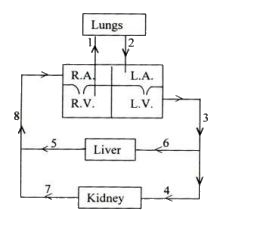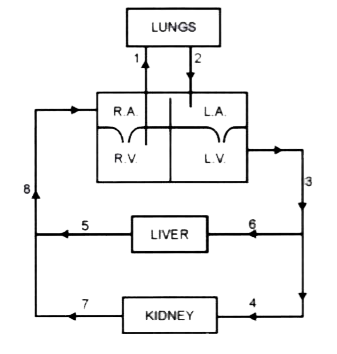Draw the sketch of a zoospore and a conidium. Mention two dissimilarities between them and atleast one feature common to both structures.
Step-by-Step Solution
Step 1: Draw the Sketch of a Zoospore
- A zoospore is typically oval in shape.
- It has a flagellum (or flagella) that extends from one end, which is used for locomotion.
Sketch of Zoospore:
_____∣∣|∣|_____∣∣∣(Fla≥llum)
Step 2: Draw the Sketch of a Conidium
- A conidium is usually a circular or oval structure.
- It is produced at the tip of a specialized structure called a conidiophore, which is elongated.
Sketch of Conidium:
_____∣∣∣∣_____∣∣∣∣(Conophore)
Step 3: Mention Two Dissimilarities Between Zoospore and Conidium
1. Flagellation:
- Zoospore is flagellated (has flagella for movement).
- Conidium is non-flagellated (lacks flagella).
2. Formation:
- Zoospores are formed inside a sporangium (endogenously).
- Conidia are formed at the tip of conidiophores (exogenously).
Step 4: Mention One Common Feature
- Both zoospores and conidia are asexual reproductive structures.
Summary
- Dissimilarities:
1. Zoospore is flagellated; Conidium is non-flagellated.
2. Zoospore is formed inside a sporangium; Conidium is formed at the tip of conidiophores.
- Common Feature: Both are asexual reproductive structures.
- A zoospore is typically oval in shape.
- It has a flagellum (or flagella) that extends from one end, which is used for locomotion.
_____∣∣|∣|_____∣∣∣(Fla≥llum)
- A conidium is usually a circular or oval structure.
- It is produced at the tip of a specialized structure called a conidiophore, which is elongated.
_____∣∣∣∣_____∣∣∣∣(Conophore)
1. Flagellation:
- Zoospore is flagellated (has flagella for movement).
- Conidium is non-flagellated (lacks flagella).
- Zoospores are formed inside a sporangium (endogenously).
- Conidia are formed at the tip of conidiophores (exogenously).
- Both zoospores and conidia are asexual reproductive structures.
- Dissimilarities:
1. Zoospore is flagellated; Conidium is non-flagellated.
2. Zoospore is formed inside a sporangium; Conidium is formed at the tip of conidiophores.
- Common Feature: Both are asexual reproductive structures.
Topper's Solved these Questions
- REPRODUCTIONBOOK - TRUEMEN BIOLOGY ENGLISHCHAPTER - REPRODUCTIONEXERCISE - SECTION -C
22 Videos
- REPRODUCTIONBOOK - TRUEMEN BIOLOGY ENGLISHCHAPTER - REPRODUCTIONEXERCISE - SECTION-D
27 Videos
- REPRODUCTIONBOOK - TRUEMEN BIOLOGY ENGLISHCHAPTER - REPRODUCTIONEXERCISE - SECTION-D
27 Videos
- Protista BOOK - TRUEMEN BIOLOGY ENGLISHCHAPTER - Protista EXERCISE - ASSERTION AND REASON
6 Videos
- Reproduction In OrganismsBOOK - TRUEMEN BIOLOGY ENGLISHCHAPTER - Reproduction In OrganismsEXERCISE - MULTIPLE CHOICE QUESTION
131 Videos
Similar Questions
Draw a rough sketch of the curves y2=xandy2=4−3x and find the area enclosed between them.
View SolutionDraw a rough sketch of the curves y2 = x and y2 = 4 – 3x and find the area enclosed between them.
View SolutionDraw a rough sketch of the curves y2=x+1andy2=−x+1 and find the area enclosed between them,
View SolutionState any two structural and one functional difference between DNA and rRNA.
View SolutionGiven below is a diagrammatic representation of a certain part of the process of circulation of blood in man. Study the same and then answer the questions that follow:

Mention two structural differences between blood vessels ‘3’ and ‘8’.
View SolutionGiven below is a diagrammatic representation of a certain part of the process of circulation of blood in man. Study the same and then answer the questions that follow :

Mention two structural differences between blood vessels '3' and '8
View SolutionGiven alongside a schematic representation of the circulatory system in man. Study the same and answer the question that follows.

Give one difference between the parts A and B based on
(a) their structure
(b) the nature of blood flowing through them
View SolutionStructure common between earthworm and cockroach is
Or Which one feature is common to leech cockroach and scorpion
View SolutionFour o'clock plant and sweet potato are similar in one aspect and dissimilar in another aspect with reference to the nature and modification of roots. Mention these two aspects.
View SolutionWrite the main structural difference between DNA and RNA. Of the four bases, common to both DNA and RNA.
View Solution
